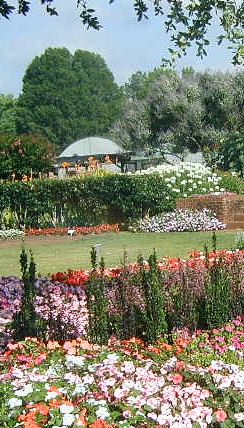
Rootloose
The Flowers that Bloom in the Spring
by Derek Burch
It is no wonder that so many people in Florida have summer places in the
Carolinas, and indeed substantial numbers give up the pleasures of the
South Florida winters and brave the cold to move there completely when
they retire.
I did my late spring pilgrimage, as I have for a few years now, going from Allan Armitage's trial garden at the University of Georgia, through the State Botanical Garden to Parks Seed, the Southeast Greenhouse Conference and the botanical garden in Atlanta. An absolute orgy of color and plant form, but an excess that leaves no hangover and has no danger of being fattening or any danger to one's health.
Allan Armitage is part of the
very strong Department of Agriculture-Horticulture which has built an
enviable record, not only for research and teaching, but for getting information
out to both home gardeners and the trade. The trial gardens, officially
the Betty Johnson Horticultural Gardens, are tucked between buildings,
and this year access by road was all but cut off by construction on campus.
The convoluted approach to the parking lot was worth taking, however,
to enjoy the welcoming sea of color that the summer trials always present.
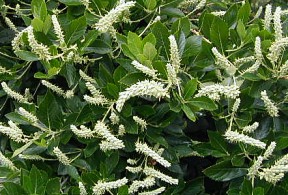 |
Plants are drawn from a wide variety of sources, and comparable plants are shown grown under identical conditions, so that it is easy to compare their performance. There is also the opportunity to vote on plants for the Georgia Garden Gold award. Many of the plants are improved selections made in the garden of plants already well known in the industry. |
|
Clethre alnifolia 'Hummingbird'
|
My other stop in Athens is at the State Botanical Garden of Georgia. I must admit that I have not explored all of the more natural parts of the more than 300 acres, but I admire the area called the international garden where attractive plantings are crafted from plants from various parts of the world. That, and the conservatory, which is small but beautifully planted and immaculately maintained, send me on the road thinking that there is a lot more to Georgia than red clay, peaches and chain gangs.
| I go the Parks trial ground before the open day, which draws more of a crowd than I put myself in voluntarily. There are always brand new plants to enjoy in a multi-acre field with bed after bed of stunning color.The pictures at the head of each page in this issue are part of the garden display, and tell the story of the skilled designs that underlie the garden. Another part of the garden is shown to the right. |
 |
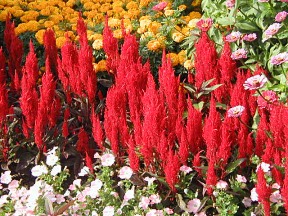 |
Standing out across the whole distance of the field, Celosia 'Century Red' was a beacon at the entrance to the trial ground. |
Greenwood, SC, home of Parks Seed, is in an area in which I expect to find great catfish - the area around it is dotted with small towns that host catfish festivals. Well, catfish there was, in plenty, and numerous restaurants serving beer, but try as I would I could not find one that served both. Is this an aspect of southern living that I have not encountered before. Watch this space, the search continues. . .
The Southeast Greenhouse Conference
is strictly a trade affair. The seminars are closely focused for sunbelt
nurseries, and have a very lively trade show associated with them. I usually
make straight for the booth by Itsaul Plants from Chamblee, Georgia. They
never disappoint with new material of asarum and hydrangea - two groups
which I can't grow but dearly love to see, but this year were offering
some attractive new oxalis and some aroids (caladium relatives) which
I can and will be growing.
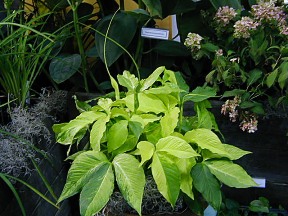 |
They are offering tissue cultured plants of Amorphophallus titanum which will be of interest to collectors. Wholesale only, unfortunately for home gardeners, but these are the people who supply the garden centers, so it is only a matter of persuading your usual nursery to order from them for you. (Not too practical if you live in the U.K. or in Australia, I admit, but you can't have everything). |
|
Pinellia pinnatisecta 'Dragon Tales'
|
So, final stop, after getting
to Atlanta and before the flight home, was the Atlanta Botanical Garden.
As always seems to be the case, they are in a major building program,
but the conservatory and the orchid house are well established, and would
be my main targets anyway. The orchid house has striking displays representing
the flora from three high elevation areas: Mt. Kinabalu, a 13,000 ft.
peak in Sabah, Malaysia; the tepuis, sandstone plateaux of the Guianas
and Venezuela; and areas of the South American Andes. Each has its own
climatic peculiarities which result in very different floras, and the
three areas are clearly explained, making a remarkable display for a garden
at such a low elevation.
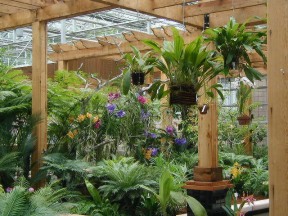 |
There is a tropical section full of color from rather more familiar orchids, and special displays at various times of the year. Both the Dorothy Chapman Fuqua Conservatory and the orchid range were built through the generosity of J.B. Fuqua, an Atlanta businessman. It is hard to imagine a better way to be remembered. |
The tropical conservatory is suffering, as so many do, from incautious planting of trees to generate the perception of a tropical forest: an attempt to show off rare species and introduce a sense of the complexity and interaction of the community. Unfortunately, tropical forests are shady and far from colorful unless you are in an area of a tree fall or along a river bank, and I suspect that some major work will soon be planned to redo the planting to incorporate sections with more of the spectacular plants that are usually hidden in the canopy. A slightly less ambitious attempt at education will give a much more enjoyable experience, and build an empathy for the forest that a more "authentic" planting rather fails to do. It must be very difficult to coax the few flowering plants into bloom - I know because I made the same mistake of going too heavily for shade over most of my own garden.
This little circuit is one that I would strongly recommend for a short break, to enjoy color and to see a variety of garden styles.I must say, however, that this year the drought and appalling weather of the past several seasons have left their mark on all the gardens. But, if anything, to a gardenener, this makes the gardens on display all the more endearing. The gardeners are only human after all. What a relief!
Back to Table of Contents